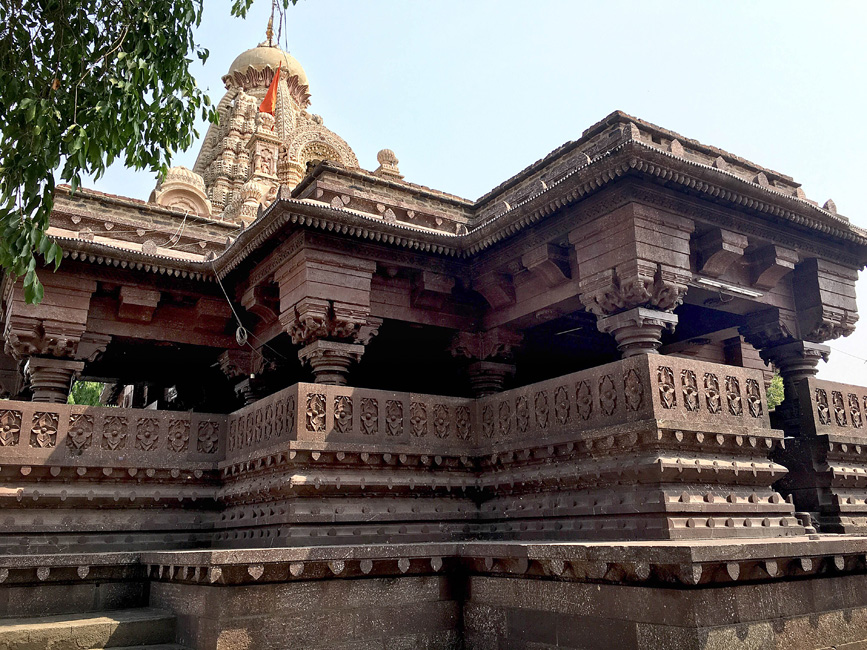
All human beings are two segmented personae – The inner one denoting the deep-rooted culture and the outer one implying our civilized self. To explore the undiscovered is an innate personality trait all humans imbibe at some level. No wonder, this strong urge to connect with the cultures and the civilizations turns into wanderlust. Travelling gives us a way to connect to something greater than ourselves, within ourselves.
Another weekend… another journey…
It was yet another weekend and this time we decided to head for the divine Jyotirlings, all situated in Maharashtra. Shri Ghrishneshwar, Shri Bhimashankar and Shri Triyambakeshwar were jotted down on our list. The destination was pious, pervaded and unearthly and we boarded for another divine sojourn.
The 518 kms journey began at 7:00 in the morning from Bhopal. Our first destination, Verul, also known as Ellora village is the divine abode to Shri Grishneshwar Jyotirlinga. After driving about 100 kms from Bhopal on Sehore-Dewas State Highway-18, we checked-in for a short break at Highway Retreat in Dodi, a fine midway food joint maintained by Madhya Pradesh Tourism Development Corporation. Driving further, the Dewas bypass guides us to Mumbai-Agra National Highway (NH 52/AH47). About 280 kms further on the same route is Madhya Pradesh Tourism’s another midway joint at Khalghat, which is somehow not up to the mark if you compare facilities with the one at Dodi. It was time again to move on after a brief tea break at Khalghat. It would be apt to mention here that our highways completely miss on account of basic public convenience facilities making the road journeys rather testing for families and especially the female folks. The government should seriously consider developing clean and hygienic public amenities to promote surface travel.
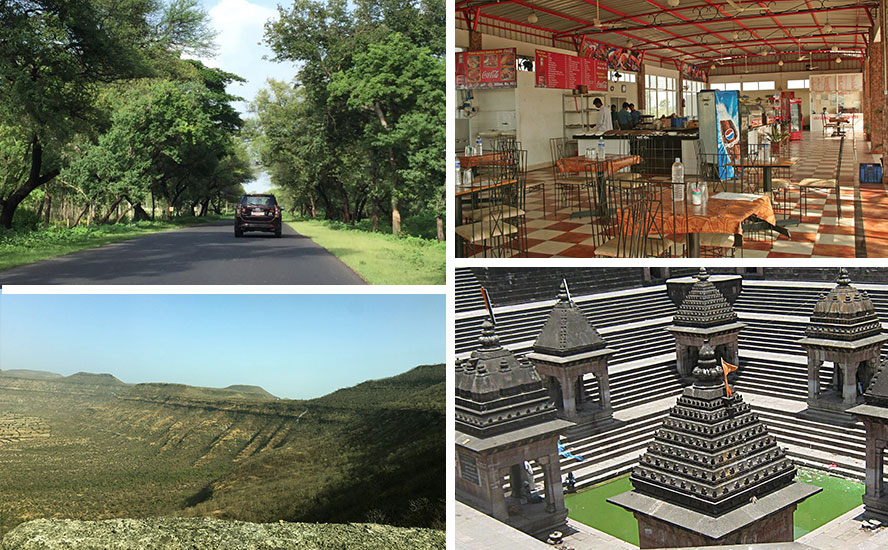
The tea break refreshed us to cruise further. As we drove through small towns and villages, highway signboards of Baal Samund, Sendhwa, Jamuniya, Palasner, Chaleesgaon continue whizzing through our curious eyes one after another. Soon we touched the Maharashtra border. A mystic aura whelmed our souls as we entered the state. The very purpose of our journey filled us with the boundless power of the pure. Every teertha dham, which we term as pilgrimage, itself justifies as a savior. A place which resonates piousness, which can be identified as a protector, which shields you from the evil, such a place definitely deserves highest of the regards. Indeed, our quest for the same is the reason that brings us to the land of Jyotirlingas, Maharashtra.
A smooth and straight road from Dhule to Verul (SH-22) until Kannada now started spiraling the expanse of Sahyadri hills unfolding beautiful scenic beauty of the surroundings. The curvy roads of the Sahyadri range would lead us to the divine destination – Shiva’s abode – Grishneshwar.
Shivalaya Sarovar & Shri Grishneshwar Temple
On the Aurangabad- Dhulia road, just before the Grishneshwar temple is Shivalaya Sarovar. Like all devotees, we must also start paying heeds to the holy pond. The river, Yela Ganga flows near the temple making it all the more pure and serene. After a holy dip, the devotees march forward to worship the pious, Gushmeshwar Jyotirlinga.
The natives here relate a mythological reference to the inception of this place. There was a king, Yela, who was cursed and infested by insects. In search for a cure, the king discovered a lake in the shape of cow hooves. He drank the holy water and got rid of the curse and the lake later sanctified as Shiva Sarovar. The great Shiva devotee, Maharani Ahilyabai Holkar, constructed 54 steps Ghat at the lake. The lake is considered as pure as an amalgamation of 8 teerthas. The emerald water lake also has a backstory as narrated by Shri Yogesh Joshi, a local conversant. According to him, the holy books refer the color of the lake water as Golden in Kritiyuga, silver in TretaYuga, blue in Dwapar Yuga and dark (sarpavichhal) in Kaliyuga, contemplated as the dark age.
Meanwhile, we became foot warriors for the journey to the temple. Out of all the holy Jyotirlingas in the country, Shiva’s Grishneshwar is the 12th. Shiva manifests here as one of his countless benign forms. Outside the temple, were the shops for prasad (offerings) and there was a string of photographers trying to click not people, but the devotion on their innocent faces. And there were swarming devotees who wanted to be blessed by the almighty.
The Grishneshwar temple is conserved by the Central Archaeological Department and hence taking camera and mobile phones inside are strictly prohibited. Once you enter the premises, it’s pleasant to see huge Neem, Peepal, Banyan and Audumbar trees covering the temple courtyard and Purohits engaged in their daily rituals under their thick soothing shadow. Devotees may get enrolled and book a schedule here for special Darshan and puja. Devotees can perform Jalabhishek for Rs 551 which would last around 15 minutes. 30 minutes Rudrabhishek puja for Rs.1100, the 45 minutes Rudrabhishek along with Mahapuja after an offering of Rs 2501 and an hour long Laghu Rudrabhishek by offering Rs11000.
The glorious Hemarpanthi architecture
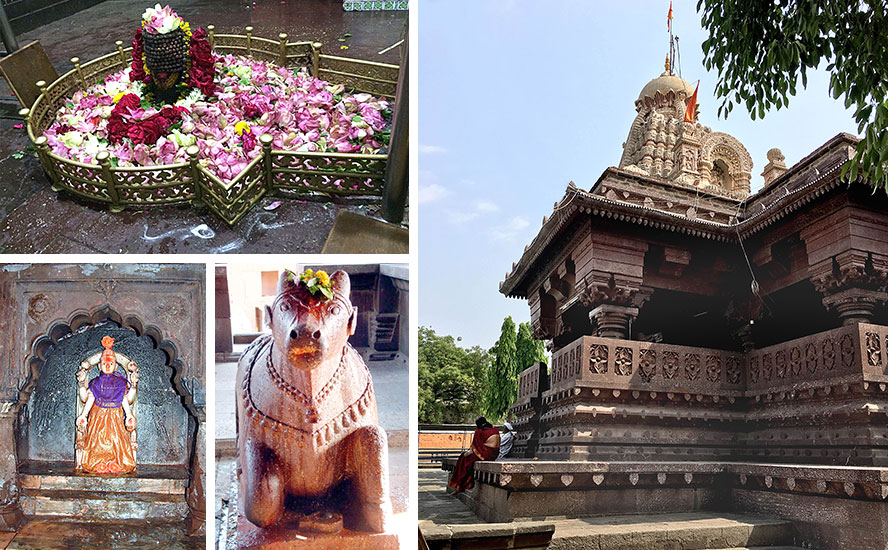
The open courtyard leads to the Shiva’s residence, as pious and honest as one could imagine. The temple has been constructed in Hemarpanthi style of architecture. Developed around 13th century in Maharashtra, the style finds its indulgence with the minister of Seyona Yadavas of the Devagiri Empire, Hemarpant, as told by, Shri Rajendra Triambakrao Kaushike, another revered scholar in the temple. He represents the 20th generation of the Kaushike family that has been serving the holy Jyotirlinga. Talking about the temple architecture, Kaushike describes that the temple is built from Basalt rocks, which were settled after volcanic lava. These Basalt rocks are considered perfect for carving in architecture, as they are soft at the time of excavation and cool down rapidly and become hard when get exposed to the climate.
These rocks with intricate carvings were used to construct the temple up to half of its height, while specially coated dark textured bricks complete the formation of rest of the temple structure up to its full height. Spread across 250X185 sq ft area and 100 ft 8 inches tall, the pillars and walls of the temple are finely layered with limestone, black urad and bael fruit. All the future threats have been managed at the structural level. The rocks have been interlocked immaculately together displaying the rare architectural excellence of the Yadavas.
The temple was built around second half of the 17th century, Kaushike ji tells as he continues sharing more about the temple’s history and architecture. The five-tier temple has a Kalasha on the rooftop (Shikhar) followed by a Brahmasutra. The nasal of the temple or the front has carving of Shiva and Parvati seated firmly on a bull. The back has engravings from the Shiva family besides figures of bullock and monkeys. The walls are decorated with stories from Ramayana, Mahabharata and Dashavtara that exhibit the inimitable flair of the artisans of that century. A beautiful sabhamandap (Common Courtyard) stands on 24 beautifully carved stone pillars and ceiling with 64 lotuses add to the archetypal beauty of the temple. The 18X18 sq ft garbha griha or the sanctum sanctorum of the temple is sanctified with the only Jyotirlinga that’s purvamukhi (east facing), Shri Grishneshwar. The last of 12 revered Jyotirlingas in the country. Perhaps drawing inferences from the last Rudravtar, the purna pradkshina of the temple also denotes the same.
As you step down into the garbh griha, effulgence of the lord who is omnipresent in Bhu, Bhuvah and Swaha fills the soul with devoutness. A mere glimpse of the enshrined divya Jyotirlinga in the sanctum sanctorum gratifies one with the luminous lord’s aura. Shiva, who resonates and echoes around and you compulsively surrender. Near jyotirlinga, Maa Parvati resides in white marble. The white halo entangles you to her pure world. The Jyotirlinga is constantly offered Jaldhara from the above depicting holy water from the heaven, emerging from the universal consciousness. The divine energies of the garbha griha binds one strongly with immense faith and determination, dwelling into all your desires, building up to explode in front of the Shiva. Here, Kaushike ji further enlightens that out of the five elements, the temple is significantly associated with agni (the fire) and hence the premises don’t allow any offering related to the same. There are no havana or offerings related to the fire. The southeast wall of the temple is situated near the temple while the northwest wall is away from the temple near an open courtyard approving the fact. The pillars of the temple are carved with Panchmukhi Hanuman, Navagraha (Nine planets), Saptamatrikaye (Seven divine mothers), Naagband and other mythological attributes.
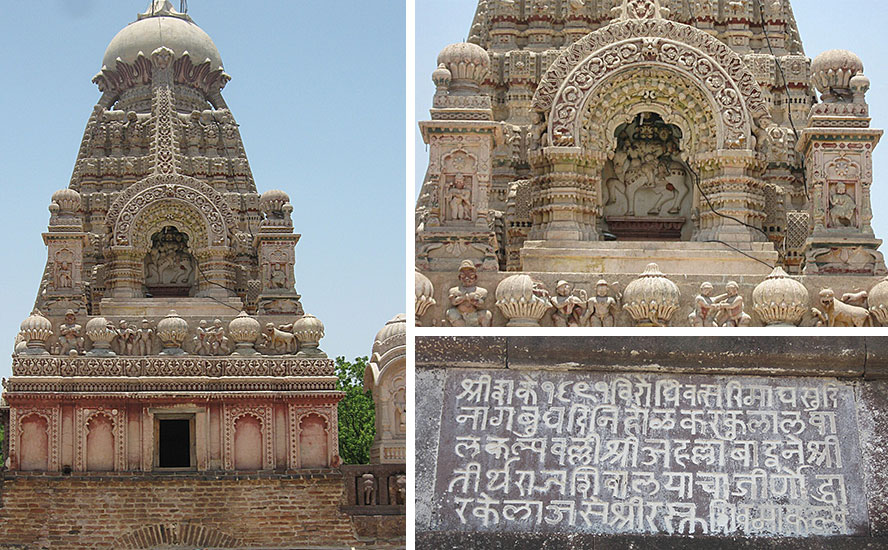
The panchdwaar façade is beautifully decorated with rudraksha motifs, gracefully enhancing beauty of the temple. The entrance, the roof, canopy, and huge Nandi and Kachhap (tortoise) idols residing in the Mandapa are soul stirring. They just gradually sink to your soul and lead you. Now another purohit, Shri Santosh Bhagwanrao Painthankar, also joined and narrates the inception of the Jyotirlinga. He continues telling about a devoted Brahmin, Sudharma whose wife Sudeha could not conceive a child. She asked her sister Ghushma to marry her husband. Ghushma agreed and from their marriage gave birth to a baby boy. But Sudeha couldn’t tolerate and became utterly jealous of her. She murdered the baby boy and threw the corpse in a lake. Shiva was angry at her deeds and charged to kill her but Ghushma begged for pardon and asked lord Shiva to bless the place instead and reside there. This story is mentioned in Shivpurana and is believed true. As the Jyotirlinga was appeared due to Ghushma’s insistence it was termed after her name- Grishneshwar. Though, it is also called Ghrishneshwar and Kumkumeshwar according to some other mythological folk narratives. Meanwhile, pujari Yogesh Joshi ji also joined the conversation. Revealing more interesting details about the temple’s history, he states that Chhatrapati Shivaji’s grandfather; Maloji Raje Bhonsle constructed this temple in the second half of the 15th century. To prove his theory he presents several texts and quotes in Marathi scriptures by Datto Trimal and Bakhar (A glorious history of Maratha clan). Rock inscriptions are present in the temple to honor the same. Some eminent names including Yekoji Jetoji Bhonsle, Das Maloji Babaji, Bithoji Baba ji Bhonsle and Sewak Aauji Goving Hanwatya have been chiseled on rock found in the temple.
The holy place was known by various names during different eras as mentioned in a holy book by Bua Topre. The book is divided into 33 chapters and in 6570 Shlokas, the same place has been called Shivalaya in Kritiyug, Shivasthaan in Treta Yug, Ilapur in Dwapar and Naagasthan in Kalyug. Patel Maloji from Verul and later Maharai Ahilyabai Holkar, who were surrendered devotees of Shiva, dedicatedly took up the restoration and reconstruction of the temple.
One can easily relate the abundance of the Nagas in this area in the ancient times. The name of the place Vaarul, in Marathi means snake pits, and over ages the name changed to Verul. River Yelaganga flowing beside was termed as Yerul Ganga, colloquially. And thus, the place gets its name Ellora. Another allegory says that King Yela had two wives – Ghrishnavati and Mankavati. Ghrishnavati was associated with Grishneshwar and Mankavati with Mankeshwar. The 16th cave of Ellora has a Kailasha Mandir and is called as Mankeshwar. Grishneshwar and Mankeshwar sharing the same coordinates perhaps support the facts behind the story. As we came out of the temple premise, three tombstones situated in the close vicinity drew our attention. The local guide informs that the tombs with Persian and Moorish influence belong to the Bhonsle dynasty.
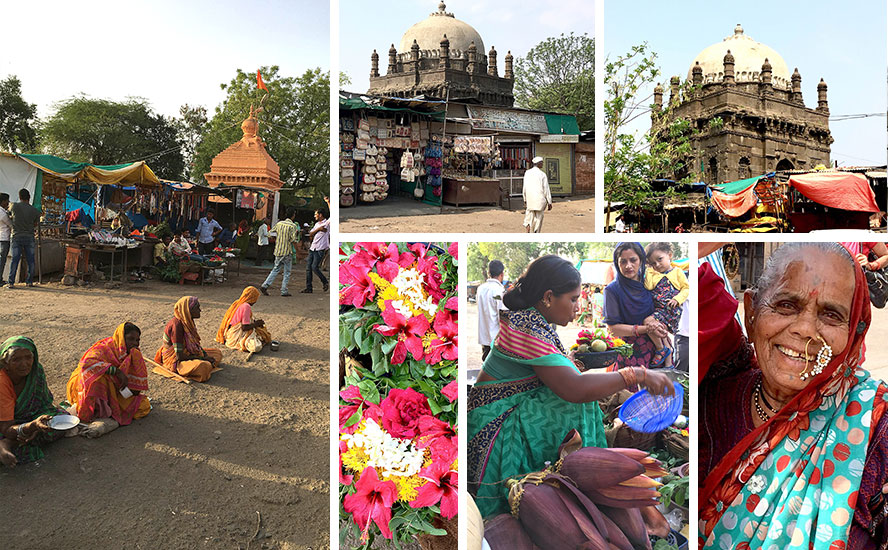
Day was coming to an end and we were over-absorbed by the power of Shiva, the god, who assumes innumerable forms in order to regulate the movement of the worlds, and to liberate embodied souls. The one by whose mere will the Sun rises every day and the Moon changes its phases, the air blows calm and seasons change. The one who maintains the worlds in an orderly way.
The Taj at Aurangabad
Feeling blessed and content after divine darshan of such benevolent supreme god, we headed back to Aurangabad. Hotel Taj Vivanta was our accompaniment for the night. About 30 minutes from the temple in Aurangabad, this Taj Group hotel is famous for its quintessential hospitality and warmth. Our suite was spacious and opened to small balconies. It was time to savor some vegetarian delicacies on comfortable hammocks. The Maharashtrian vegetarian specialties like vadapav, bharli vaangi, bhindi fry, varan daal – bhaat were just the perfect end to a perfect day and we were ready for a good night’s sleep.
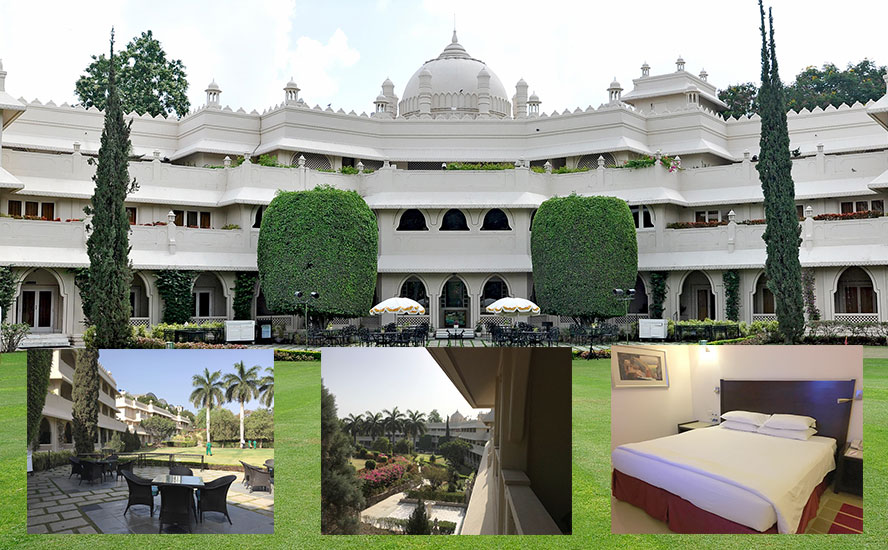
As the night seeped in and we prepared to sleep, our minds were thinking about the purity and sweetness of the vivacious Maratha culture that totally blends with the sweetness of sugarcane, the main crop of this land, the sweet impact of which drips all over the culture and tradition of this beautiful state. Immense warmth and liberal personalities make people here fragile preparing for the situations with utmost sincerity. Simple yet glorious culture is definitely a lesson one should learn from the great Indian rural traditions. And with such thoughts we surrendered to sleep. But the journey continues. Stay in touch…

This is more useful info than I can find so far.